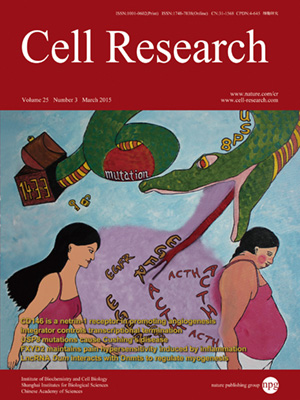
Volume 25, No 3, Mar 2015
ISSN: 1001-0602
EISSN: 1748-7838 2018
impact factor 17.848*
(Clarivate Analytics, 2019)
Volume 25 Issue 3, March 2015: 351-369
ORIGINAL ARTICLES
p53 isoform Δ113p53/Δ133p53 promotes DNA double-strand break repair to protect cell from death and senescence in response to DNA damage
Lu Gong1, Hongjian Gong1, Xiao Pan1, Changqing Chang3, Zhao Ou1, Shengfan Ye1, Le Yin1, Lina Yang1, Ting Tao2, Zhenhai Zhang4, Cong Liu5, David P Lane6, Jinrong Peng2 and Jun Chen1
1Key laboratory for Molecular Animal Nutrition, Ministry of Education, Innovation Center for Signaling Network, College of Life Sciences
2College of Animal Sciences, Zhejiang University, 866 Yu Hang Tang Road, Hangzhou, Zhenjiang 310058, China
3College of Natural Resources and Environment, South China Agricultural University, Guangzhou, Guangdong 510650, China
4National Key Laboratory of Organ Failure Research, National Clinical Research Center for Kidney Disease, and Division of Nephrology, Nanfang Hospital, Southern Medical University, Guangzhou, Guangdong 510515, China
5Developmental and Stem Cell Institute, West China Second University Hospital, Sichuan University, Chengdu, Sichuan 610041, China
6Biomedical Research Council, Agency for Science and Technology Research, Singapore
Correspondence: Jun Chen, E-mail: chenjun2009@zju.edu.cn; Jinrong Peng,(pengjr@zju.edu.cn)
The inhibitory role of p53 in DNA double-strand break (DSB) repair seems contradictory to its tumor-suppressing property. The p53 isoform Δ113p53/Δ133p53 is a p53 target gene that antagonizes p53 apoptotic activity. However, information on its functions in DNA damage repair is lacking. Here we report that Δ113p53 expression is strongly induced by γ-irradiation, but not by UV-irradiation or heat shock treatment. Strikingly, Δ113p53 promotes DNA DSB repair pathways, including homologous recombination, non-homologous end joining and single-strand annealing. To study the biological significance of Δ113p53 in promoting DNA DSB repair, we generated a zebrafish Δ113p53M/M mutant via the transcription activator-like effector nuclease technique and found that the mutant is more sensitive to γ-irradiation. The human ortholog, Δ133p53, is also only induced by γ-irradiation and functions to promote DNA DSB repair. Δ133p53-knockdown cells were arrested at the G2 phase at the later stage in response to γ-irradiation due to a high level of unrepaired DNA DSBs, which finally led to cell senescence. Furthermore, Δ113p53/Δ133p53 promotes DNA DSB repair via upregulating the transcription of repair genes rad51, lig4 and rad52 by binding to a novel type of p53-responsive element in their promoters. Our results demonstrate that Δ113p53/Δ133p53 is an evolutionally conserved pro-survival factor for DNA damage stress by preventing apoptosis and promoting DNA DSB repair to inhibit cell senescence. Our data also suggest that the induction of Δ133p53 expression in normal cells or tissues provides an important tolerance marker for cancer patients to radiotherapy.
10.1038/cr.2015.22
FULL TEXT | PDF
Browse 2426


